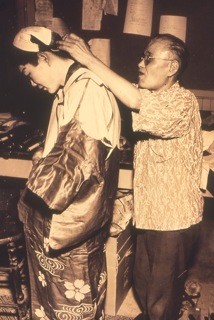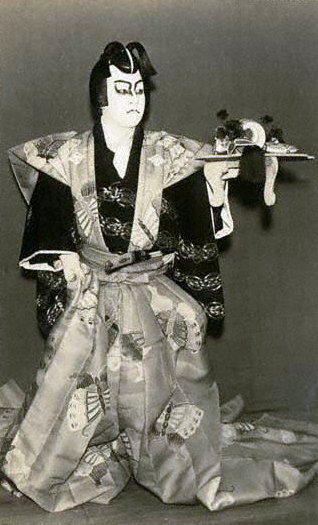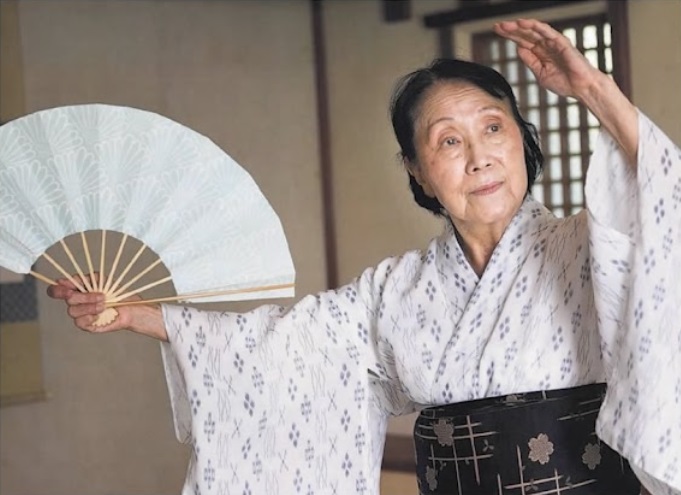
Arthur E. “Doc” Wyman
Arthur Wyman came to the University of Hawaiʻi as an Assistant Professor of Dramatic Art within the English Department in 1930, and was a faculty advisor and director of the University of Hawaiʻi Theatre Guild, which operated from 1930-1940 with the mission to produce “one Japanese, one Chinese, one Hawaiian and one Haole” play each year.

Hisamatsu Shusui (Hosokawa Zenjirō )
Hisamatsu Shusui originally came to Hawaiʻi in 1918. Together with his wife, “Mr. and Mrs. Hisamatsu” were the main advisors for movement for pre-war English language kabuki productions by the University of Hawaiʻi Theatre Guild, from 1931-1940.

Katsura Tamimaru (dates unknown)
Katsura Tamimaru likely arrived in Hawaiʻi in the early 19th century and served as wigmaster for many touring and local kabuki productions. He also served as wigmaster for several pre-war University of Hawaiʻi Theatre Guild kabuki productions between 1931-1940, as well as providing the wigs for the 1953 production of Benten Kozo or Five Thieves, directed by Earle Ernst.

Earle Ernst (1911-1994)
“Earle Ernst was assigned oversight of censoring Japanese plays at the time of the American Occupation, which allowed him to learn and come to appreciate kabuki. As a result of his experiences he directed kabuki at the University of Hawai’i and became the founding director of the university’s Asian Theatre Program.”
James R. Brandon

Onoe Kuroemon II (1922-2004)
Onoe Kuroemon II (born Terashima Kiyoaki) was a kabuki actor specializing in aragoto male roles. Between 1951 and 1963, he made frequent visits to the U.S. to teach at various universities or as part of a kabuki tour. He was the first Shochiku Grand Kabuki actor to collaborate with UHM on an English-language kabuki production.

James R. Brandon (1927-2015)
A force in the development of Asian theatre studies since the 1960s, James Brandon worked on Southeast Asian, pan-Asian, and especially Japanese forms. His directing and teaching at the UHM helped build a program where performance of Asian genres and scholarship intertwine. In 1965, along with Andrew T. Tsubaki and Farley Richmond, he founded the Afro-Asian Theatre Project, which became the Association for Asian Performance in 1987. He also co-founded the Asian Theatre Journal with Elizabeth Wichmann-Walczak in 1984. He translated and directed numerous kabuki productions at UHM, from 1970 to 2000.

Gertrude Tsutsumi (Onoe Kikunobu), b. 1929
Gertrude Yukie Tsutsumi is one of most significant nihon buyō (Japanese classical dance) artists in Hawai’i. She began her training in the Bandō School in Honolulu, and later studied Onoe school in Japan, where she earned her shihan (master of dance diploma), receiving the professional name Onoe Kikunobu. Since 1980, she has been a lecturer at the University of Hawai’i, where she has been a principal dance and movement resource for UH Kabuki.

Chie Yamada
Born in Tokyo, Chie Yamada was an accomplished nagauta shamisen player and kato bushi singer. In 1965, she moved to Hawai’i with her husband and taught shamisen in the UH Mānoa Music Department from 1966 to 1992. Chie Yamada served as the Musical Director for seven UH Kabuki productions.

Nakamura Matagoro II (1914-2009)
A leading teacher at Japan’s National Theatre Actor Training Center, Nakamura Matagorō II (born Nakamura Yukio) took part of his first U.S. kabuki tour in 1960. He directed the 1979 The Forty-Seven Samurai and served as the Artistic Adviser for a number of UH Kabuki productions, including Narukami the Thundergod, presented in 1973 and 1987, and Sukeroku: The Flower of Edo in 1995.

Jōji Wago
George (Jōji) Wago trained as a nihon buyo (Bandō-ryū) before becoming interested in becoming a stylist after encountering Katsura Tamimaru in the early 1950s. He apprenticed with a wig master in Tokyo, introduced via Shochiku corporation, which owns and operates kabuki venues, and costume and wig companies for Grand Kabuki. This arrangement was made possible by Earle Ernst, chair of the Department of Drama at UHM at the time. After his return to Hawai’i, George Wago was UH Kabuki’s principal wig stylist until 2011.
Guest artists for The Maiden Benten and the Bandits of the White Waves
